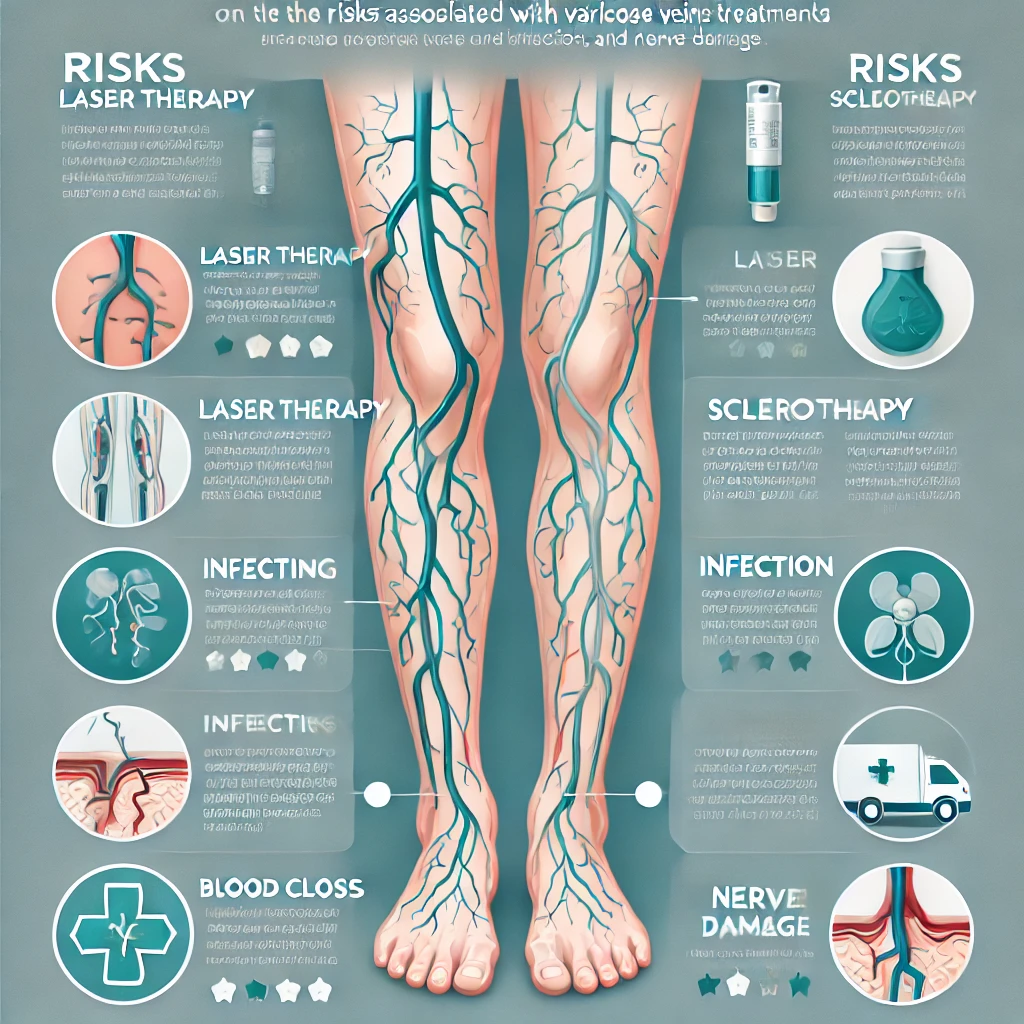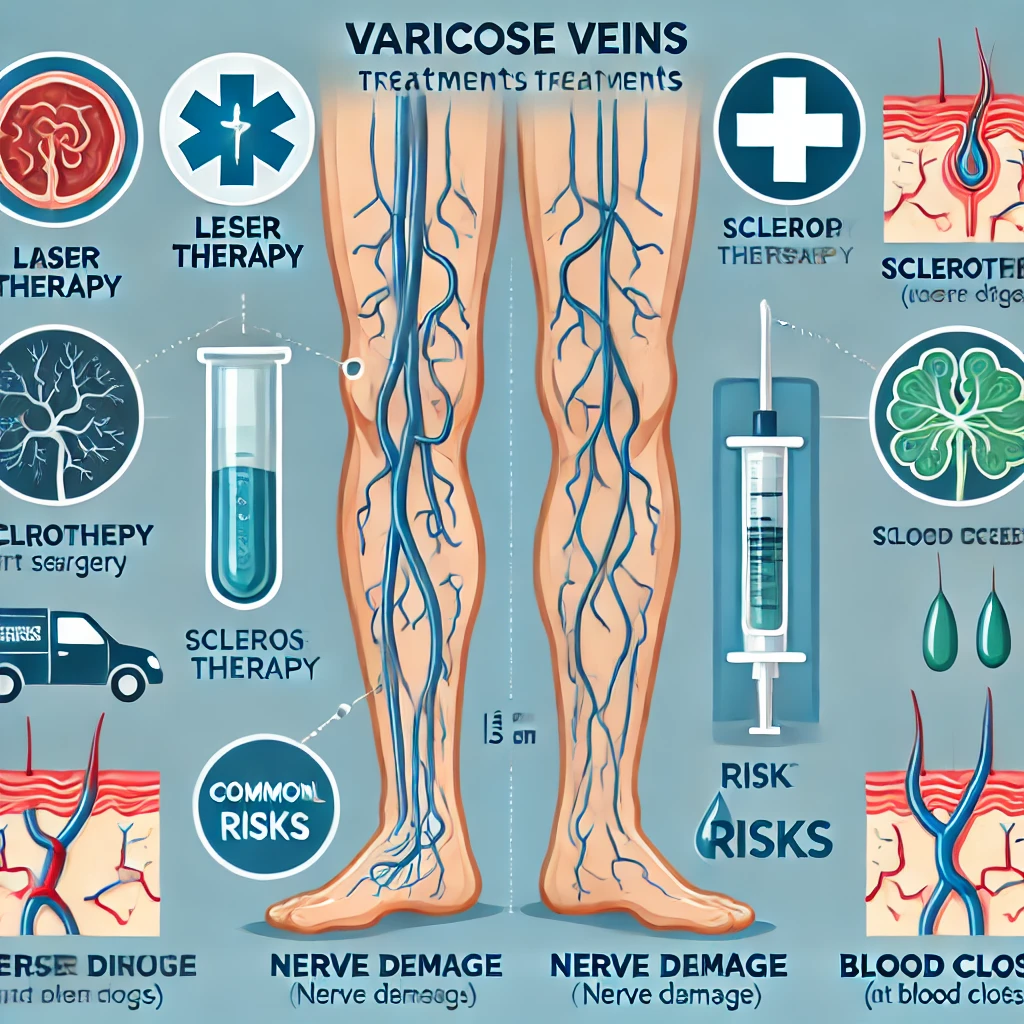Varicose veins are a common condition, affecting millions worldwide. Many people seek treatments to alleviate discomfort, improve appearance, and prevent complications. But as with any medical procedure, varicose vein treatments carry some risks. Understanding these risks, alongside the benefits, can help patients make informed decisions and manage expectations.
Let’s explore the potential risks associated with popular varicose vein treatments, what to expect, and how to minimize potential complications.
Understanding Varicose Veins
Varicose veins occur when veins become swollen, twisted, and often visible beneath the skin, usually on the legs. These veins form due to faulty valves within the vein, which fail to regulate blood flow correctly, causing blood to pool. Symptoms of varicose veins can range from mild discomfort to aching pain, swelling, and, in severe cases, skin ulcers or blood clots.
Also Read: 10 Essential Lifestyle Changes After a Stroke for a Healthier Recovery
Common Varicose Vein Treatments and Potential Risks
Several varicose vein treatment options are available today, each with its own benefits and associated risks. Here’s a closer look at these treatments and the potential complications that can arise from each.
1. Sclerotherapy
Sclerotherapy is a minimally invasive treatment where a solution, typically a chemical, is injected directly into the varicose vein, causing it to collapse and eventually fade. It’s highly effective, especially for smaller varicose and spider veins, but does carry some risks:
- Allergic Reactions: Some individuals may experience an allergic reaction to the sclerotherapy solution.
- Skin Discoloration: Brownish discoloration may appear on the skin after treatment, although it often fades with time.
- Pain and Swelling: Some mild pain or swelling can occur in the treated area, usually subsiding within a few days.
- Blood Clots: Rarely, sclerotherapy can lead to blood clots in deeper veins (deep vein thrombosis).

2. Endovenous Laser Therapy (EVLT)
Endovenous Laser Therapy uses laser heat to close off a varicose vein. It’s commonly used for larger veins and offers a high success rate with minimal invasiveness. However, there are some associated risks:
- Burns or Skin Damage: Laser therapy involves heat, so there is a slight risk of burns or skin damage.
- Nerve Injury: In rare cases, nerves near the vein can be damaged, causing temporary numbness.
- Infection: Although infrequent, infection at the puncture site can occur.
- Blood Clots: As with sclerotherapy, there is a small risk of developing blood clots.
3. Radiofrequency Ablation (RFA)
Radiofrequency ablation (RFA) involves using radiofrequency energy to heat and close varicose veins. This is similar to laser therapy but uses radio waves instead of laser heat. RFA is effective but carries specific risks:
- Skin Burns: Due to the heat, there’s a slight risk of skin burns.
- Nerve Injury: Nerve damage is possible, especially in areas where nerves are close to the surface.
- Deep Vein Thrombosis (DVT): Although uncommon, DVT can occur and requires prompt medical attention.
4. Vein Stripping and Ligation
Vein stripping and ligation is a surgical procedure where the problematic vein is tied off and removed. This is usually reserved for severe cases and has a longer recovery time. Some risks of this surgery include:
- Infection: Since it’s a surgical procedure, infection at the incision sites is possible.
- Bruising and Scarring: Patients may experience bruising and some scarring.
- Blood Clots: As with other treatments, there’s a risk of developing blood clots post-surgery.
- Nerve Damage: In rare cases, nerves may be damaged during the procedure, leading to numbness or tingling.
Also Read: Top 7 Lifestyle Changes That Complement Stroke Medications for Better Recovery
5. Ambulatory Phlebectomy
Ambulatory phlebectomy is a minor surgical procedure where the surgeon makes small incisions to remove varicose veins. While less invasive than full surgery, it still carries some risks:
- Bruising and Swelling: Minor bruising and swelling are common but temporary.
- Scarring: Small scars may be visible after the procedure.
- Infection: There’s a slight risk of infection at the incision sites.

General Risks Common to Varicose Vein Treatments
Regardless of the specific procedure, there are some general risks that patients may experience, including:
- Pain or Discomfort: Most treatments come with some level of discomfort, though this is often temporary.
- Swelling and Bruising: Swelling and bruising are typical but tend to resolve within a few weeks.
- Blood Clots: Any procedure that impacts blood vessels carries a risk of blood clots. Symptoms like swelling, pain, or warmth should prompt immediate medical evaluation.
- Infection: Proper aftercare significantly minimizes the risk of infection, but it remains a possibility, especially with surgical options.
- Recurrence of Varicose Veins: While treatments are often effective, varicose veins can reoccur over time, especially without lifestyle changes or preventive care.
Minimizing the Risks of Varicose Vein Treatments
Taking certain precautions can help minimize the potential risks associated with varicose vein treatments. Here are some best practices:
- Choose an Experienced Specialist: Working with a qualified and experienced specialist can significantly reduce the risk of complications.
- Discuss Allergies: Before procedures like sclerotherapy, make sure to discuss any known allergies with your provider.
- Follow Aftercare Instructions: Post-treatment care is essential. This may include wearing compression stockings, avoiding heavy lifting, and maintaining good hygiene around incision sites.
- Stay Active: Light walking and movement after treatment can help reduce the risk of blood clots.
Who Should Avoid Varicose Vein Treatments?
While varicose vein treatments are generally safe, they may not be recommended for everyone. People who should exercise caution include:
- Pregnant Individuals: Pregnancy can increase the risk of varicose veins, but most doctors recommend waiting until after childbirth to pursue treatment.
- Individuals with Blood Clotting Disorders: People with a history of blood clots or clotting disorders may have a higher risk of complications.
- People with Severe Health Conditions: Chronic health conditions like diabetes or autoimmune diseases can affect healing and increase infection risks.
Are Varicose Vein Treatments Safe?
For most people, varicose vein treatments are safe and effective, especially when performed by an experienced professional. However, understanding the potential risks can help you make a well-informed decision. In most cases, the risks are low and manageable, and the benefits, such as improved comfort, appearance, and quality of life, can be significant.
Also Read: What Conditions Does an Endovascular Surgeon Treat?

Frequently Asked Questions
What is the safest treatment for varicose veins?
Minimally invasive treatments like sclerotherapy and EVLT are considered among the safest for treating varicose veins. Consulting with a vein specialist can help determine the best option based on individual needs.
Can varicose veins come back after treatment?
Yes, varicose veins can return, especially if underlying risk factors aren’t addressed. Lifestyle changes like regular exercise and wearing compression stockings can help prevent recurrence.
How long is the recovery time after varicose vein treatment?
Recovery time varies by treatment type but generally ranges from a few days to several weeks. Minimally invasive treatments have quicker recovery times than surgical options.
Are there natural ways to manage varicose veins?
Yes, lifestyle changes such as regular exercise, maintaining a healthy weight, and elevating the legs can help manage symptoms and prevent new varicose veins from forming.
What are the signs of a blood clot after varicose vein treatment?
Symptoms include swelling, warmth, redness, and pain in the treated leg. If you experience these, contact a healthcare provider immediately.
Is varicose vein treatment covered by insurance?
In many cases, insurance will cover varicose vein treatment if it’s deemed medically necessary, such as when causing pain or affecting mobility.
Conclusion
Varicose vein treatments offer significant relief for many, improving both physical comfort and appearance. While treatments are generally safe, knowing the potential risks and taking necessary precautions is vital to ensure the best possible outcomes. Consult a vein specialist to discuss the treatment options that suit your needs and make a fully informed decision. For most, the benefits far outweigh the risks, leading to improved mobility, comfort, and quality of life.




